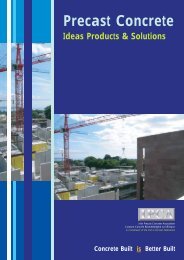Concrete Today May 2010 - the Irish Concrete Federation
Concrete Today May 2010 - the Irish Concrete Federation
Concrete Today May 2010 - the Irish Concrete Federation
Create successful ePaper yourself
Turn your PDF publications into a flip-book with our unique Google optimized e-Paper software.
concrete today - acropolis museum<br />
feet) and a full range of modern visitor<br />
amenities, <strong>the</strong> New Acropolis Museum<br />
will tell <strong>the</strong> complete story of life on <strong>the</strong><br />
A<strong>the</strong>nian Acropolis and its surroundings.<br />
It will do so by uniting collections that are<br />
currently dispersed in multiple institutions,<br />
including <strong>the</strong> outdated Acropolis Museum<br />
(built in <strong>the</strong>19th century with gallery space<br />
of 1,450 square meters, or 15,500 square<br />
feet). The rich collections will provide<br />
visitors with a comprehensive picture of<br />
<strong>the</strong> human presence on <strong>the</strong> Acropolis,<br />
from pre-historic times through late<br />
Antiquity. Integral to this program is <strong>the</strong><br />
display of an archaeological excavation on<br />
<strong>the</strong> site of <strong>the</strong> Museum itself: ruins from<br />
<strong>the</strong> 4th through 7th centuries A.D., left<br />
intact and protected beneath <strong>the</strong> building<br />
and made visible through <strong>the</strong> first floor.<br />
O<strong>the</strong>r program facilities include a 200-seat<br />
auditorium.<br />
Archaeological excavation<br />
Par<strong>the</strong>non friezes gallery area<br />
of museum. Light for <strong>the</strong> exhibition of<br />
sculpture differs from <strong>the</strong> light involved<br />
in displaying paintings or drawings. The<br />
new exhibition spaces could be described<br />
as a museum of ambient natural light,<br />
concerned with <strong>the</strong> presentation of<br />
sculptural objects within it, whose display<br />
changes throughout <strong>the</strong> course of <strong>the</strong> day.<br />
Second, <strong>the</strong> visitor’s route through <strong>the</strong><br />
museum forms a clear three-dimensional<br />
loop, affording an architectural promenade<br />
with a rich spatial experience that extends<br />
from <strong>the</strong> archaeological excavations to <strong>the</strong><br />
Par<strong>the</strong>non Marbles and back through <strong>the</strong><br />
Roman period. Movement in and through<br />
time is an important aspect of architecture,<br />
and of this museum in particular. With<br />
over 10,000 visitors daily, <strong>the</strong> sequence of<br />
movement through <strong>the</strong> museum artefacts is<br />
designed to be of <strong>the</strong> utmost clarity.<br />
Third and finally, <strong>the</strong> building is<br />
divided into a base, middle, and top,<br />
Architectural Description<br />
Three concepts turn <strong>the</strong> constraints<br />
and circumstances of <strong>the</strong> site into an<br />
architectural opportunity, offering a simple<br />
and precise museum with <strong>the</strong> ma<strong>the</strong>matical<br />
and conceptual clarity of ancient Greece.<br />
First, <strong>the</strong> conditions animating <strong>the</strong> New<br />
Acropolis Museum revolve around natural<br />
light – more than in any o<strong>the</strong>r type<br />
Archaeological excavation<br />
concrete today<br />
13





